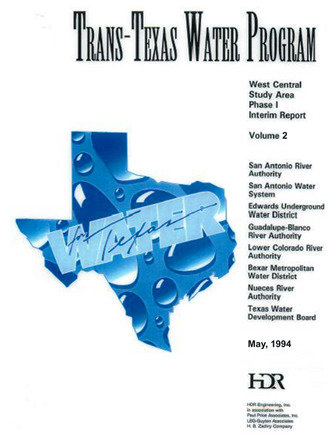Trans-Texas Water Program West Central Study Area Phase I Interim Report Volume 2

| Author | HDR Engineering Inc, Paul Price Associates Inc, LBG-Guyton Associates and Espey-Huston & Associates Inc, San Antonio River Authority, San Antonio Water System, Edwards Underground Water Distric, Guadalupe-Blanco River Authority, Bexar Metropolitan Water |
| Year | 1994 |
| Description | Interim Phase I West Central Texas water plan for the Trans-Texas Water Program. Volume 2 contains Water Supply Alternatives and Evaluations and Appendices A-D. Note: This study is included for historical value but has been replaced by more recent plans. |
| Report Number | Phase I Volume 2 |
| Publisher | HDR |
| Location | West Central Texas |
| Cover | View Download |
| File | View Download |
| Summary |
|
Note: This study is included for historical value but has been replaced by more recent plans. In the 1990 Texas Water Plan, the projections of population and water demand growth identified immediate water supply needs in the metropolitan areas of Southeast and South Central Texas (San Antonio, Corpus Christi, and Houston). The 1990 Water Plan also identified significant quantities of surplus supply in some river basins. The Trans-Texas Water Program (TWDB) has been created under the leadership of the Texas Water Development Board and with the sponsorship of many of the State’s river authorities to address the water supply needs of these areas in an environmentally responsible, coordinated, and economical manner. The Trans-Texas Water Program is a multiple-phase program beginning with Phase I planning studies to determine projected water demands and supplies through the year 2050 and to identify possible water supply alternatives to meet future needs. This Phase I report provides: (1) projections of water demands of the study area for the period 1990 to 2050; (2) comparisons of projected demands to existing supplies; (3) potential water supply alternatives to meet the needs of the area; and, (4) a reconnaissance level assessment of the water supply potentials, costs, and environmental effects of each option. From this, decisions can be made regarding viable water supply alternatives to be studied in more detail in Phase II. Alternatives chosen to be considered further will require significant environmental, hydrologic, and economic study prior to a project or management plan being implemented. The West Central Study Area of the Trans-Texas Water Program includes all of the San Antonio and Guadalupe River Basins, parts of the Nueces, Colorado and Brazos River Basins, and parts of the San Antonio-Nueces, Lavaca-Navidad, and Brazos-Colorado Coastal Basins. The study area is shown in Figure ES-l and includes 33 counties. Major population centers of the region are the cities of San Antonio, Austin, San Marcos, New Braunfels, Round Rock, Victoria, and Seguin. A significant portion of the West-Central Study area is highly dependent on groundwater supply from the Edwards Aquifer, which is used extensively for municipal, manufacturing, irrigation, and livestock watering. Within the study area, 1.36 million people benefit directly or indirectly from the water supply provided by the Edwards Aquifer to wells or springflows, and by year 2050, the population potentially affected by the aquifer is projected to be 3.7 million. The current dependence on this single water source, coupled with the projected growth of the area and the resulting need for additional water, makes water supply planning essential. Development of alternative water supplies not only is needed to meet growth demands, but to maintain significant ecosystems at Comal and San Marcos Springs. The TWDB, through the Trans-Texas Water Program, has brought together eight sponsors that collectively commissioned this Phase I study. Alternatives studied include existing surface and groundwater supplies, conservation, reuse, changes in use of existing supplies, potential development of new surface and groundwater sources, and inter-basin transfers. For each water supply option, this screening study provides preliminary estimates of yields, costs, and environmental impacts, for use in making policy decisions for the long term water supply of the area. Volume 2 contains Water Supply Alternatives and Evaluations and Appendices A-D. |
Search for Documents
Advance Search
Explore EAA's Scientific Reports
- All Reports
- Overview Studies
- Modeling
- Hydrology and Hydrogeology
- History
- Groundwater Recharge, Recharge Zone
- Groundwater Movement
- Geomorphology and Caves
- Weather Modification
- Geology
- Water Use and Conservation
- Geochemistry
- Water Resources Planning and Management
- Floods and Drought
- Water Quality
- Climatology
- Surface Water / Groundwater Relationship
- Biology
- Springs, Groundwater Discharge
- Archaeology
- RZ Protection
- Aquifer Levels
- Remote Sensing
- Precipitation
